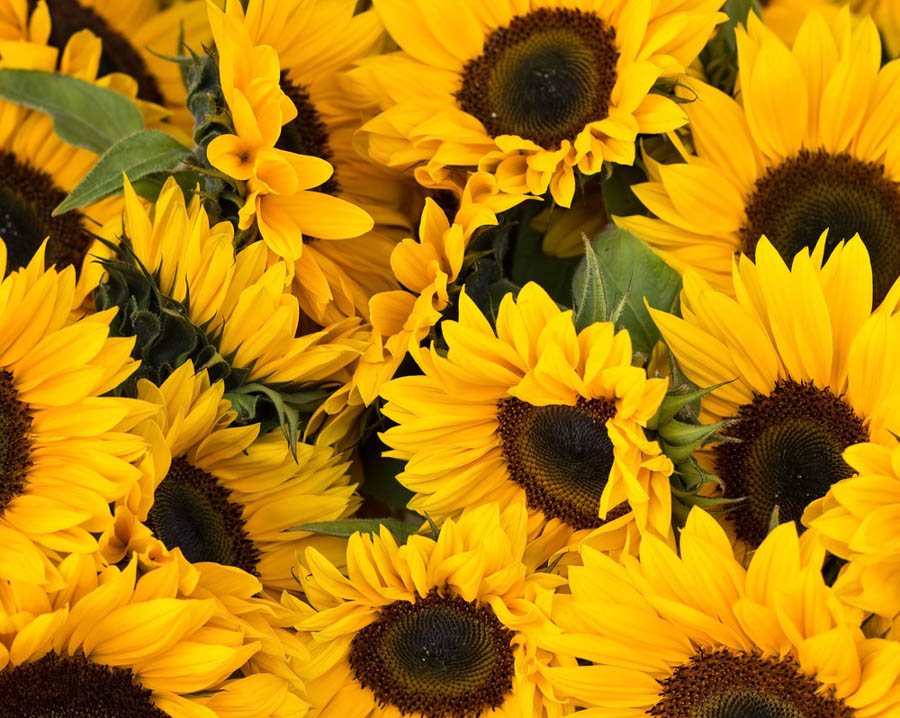Sunflower Varieties: Growing for Seeds and Cut Flowers

GardenZeus receives commissions on sales made through links in this post. There is no additional cost to you.
Interested in growing sunflowers? First decide if you are going to use sunflowers for seed or for cut flowers.
For a sunflower variety attractive enough to use as a cut flower but productive enough to harvest for seeds, GardenZeus recommends Taiyo, a classic, single-stemmed, large-headed Japanese heirloom that grows up to 6 feet and produces heads up to 10 inches in diameter. Typical of sunflowers primarily grown for seed, the center of the Taiyo sunflower is particularly large compared to its rays, or “petals.” For a sunflower variety used solely for edible seeds or birdseed, GardenZeus recommends Mammoth Russian, a single stem sunflower that grows up to 15 feet and produces seed-laden flower heads up to 2 feet in diameter. Practice sustainable living and grow Hopi Black Dye Sunflowers: harvest the heads for seed and use the seeds both for eating and dying baskets, just as the Hopi people did.
Gardeners who grow sunflowers for cut flowers have a wide range of choices and colors; they should begin by choosing between single stem or branching varieties. Single stem sunflower varieties produce one flower head from one seed. Very strong stems support these flower heads which can last in water for up to two weeks. However, gardeners must be prepared to plant seeds successively to ensure a regular supply of sunflowers over a period of time. Many single stem varieties have been hybridized for large-scale commercial production. Unlike single stem sunflowers, branching varieties produce numerous sunflower heads from one seed over the growing period, eliminating the need for successive planting. And branching varieties are available in a huge range of colors and sizes. However, these sunflowers grow on stems that tend to be shorter, weaker and shorter- lived than single stem varieties. And branching varieties typically have a longer time to harvest and require more space.
For use as cut flowers, some single stem and branching sunflowers have been bred to be sterile, meaning that these sunflowers will not shed pollen when placed in a vase on your table.
To grow single stem sunflowers that look like they came from the local florist, GardenZeus recommends Zohar F1 Hybrid, a classic dark yellow sunflower with a very long vase life. Zohar F1 Hybrid produces heads up to 6 inches on plants that grow to 60 inches. And the flowers are sterile.
For a classic branching sunflower, Garden Zeus recommends Soraya , the first sunflower to receive an AAS award. Soraya produces heads of up to 6 inches on sturdy branches of up to 48 inches with as many as 25 branches per plant. Flower heads have minimal pollen. Soraya is also day-neutral, requiring less sun to produce blossoms and making it a good choice for growing in either early spring or fall. A standout branching variety is Ring of Fire, an AAS winner and spectacular bicolor sporting dark red rays with gold edges and dark centers. Other branching sunflowers are available in an array of colors: Lemon Queen (light yellow rays and with dark centers, a favorite of bees); InfraRed Mix F1 (dark maroon rays and sterile flowers); Shock-o-Lat (dark brown rays with yellow edges and dark centers) ; Moulin Rouge (dark red rays and sterile flowers); and Chocolate (open-pollinated with brown rays and centers.) For growing branching sunflowers in a variety of colors, GardenZeus highly recommends Autumn Beauty, a mix of different autumn, yellow, orange and bronze sunflowers.
Want to grow a sunflower that looks like a chrysanthemum? Try Teddy Bear, a branching variety with 3 to 5 inch sunny yellow fluffy rays, light centers and minimal pollen. And as a dwarf variety, Teddy Bear can be grown at the front of a flower bed or in containers.
Need a traditional sunflower with yellow rays and dark centers for a container? Look no farther than the branching dwarf Sunny Smile. It sports 2 to 5 inch heads on a plant that grows to no more than 20 inches. And its flowers are sterile.
GardenZeus has customized growing information by plant and zip code. To get started, enter your zip code here.
Make sure you know our soil before you plant. Articles of interest include:
Mud Pies and Fizz: Easy Home Tests for Soil pH
Tips for Testing Soil pH at Home With a Soil Test Meter
